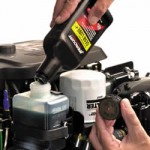Winterize Your Boat
In: Boating
1 Oct 2010 Before you put your boat on ice for the winter, here’s what you need to do to protect your investment.
Before you put your boat on ice for the winter, here’s what you need to do to protect your investment.
Why put time and money into a boat that you’re not going to use for six months? That’s an all-too-common attitude when it comes to winterizing chores. Beeeg mistake. Winter weather can wreak havoc (cracked blocks, corrosion, etc.) on a boat that’s not prepared for hibernation. Another tip: If your boat needs professional help and you wait until spring to get it, you’re hitting the boat doctor at his busiest time. So it pays to take care of any problems and dealer-required maintenance in the fall, before your craft is clutched by winter’s icy grip.
The Hull Story
Winterizing is more than just sloshing in some fuel stabilizer, draining the engine and adding antifreeze. Consider it to be a methodical process that runs from bow to transom. Because boats and engines differ, start by checking the winterizing/storage sections of your owner’s manual.
Fiberglass is made to stand up to the ravages of summer sun and salt water, so a little snow is not a problem – or is it? Ice accumulation can split open hatches and window tracks, causing leaks. So outside storage demands the proper boat cover. More on this later.
Check the hull, looking for stress cracks (common around the bow eye) and gelcoat blisters. Stress cracks can indicate structural damage, and anything serious should be looked at by a professional. The drill with blisters is to puncture, drain, dry and patch with an epoxy-based filler made for this purpose. If your hull is aluminum, bang the drum slowly with a rubber mallet to knock out dents.
Barnacles and any other unwelcome guests tagging along on your boat bottom should have their free-ride privileges terminated by scraping and then sanding any residue. A good pressure washing is in order to remove dirt and the dreaded sea scum. You’ll make this job a lot easier in the future if you apply a product such as 3M’s Marine Ultra Performance Paste Wax. It creates an acrylic shield over the hull to prevent dirt from penetrating into the wax. The crud stays on the surface where it can be hosed off easily.



Inside Scoop
Winter air can be humid or dry, and both conditions can bring grief to vinyl interiors. Vinyl cleaners and protectants, available in gels and sprays, can prevent your vinyl from drying out and cracking. More insidious is moisture that opens the door to mildew. More than one boat owner has unzipped his boat in the spring only to find the interior looking like a science project with mold and mildew everywhere. The fix here is to vent your boat cover for good airflow to minimize trapped moisture. Mildew sprays are a big help, as are chemical dehumidifiers that pull excess moisture from the air.
Not content with just getting cozy with your interior, moisture likes to do other nasty things, like corrode your on-board electronics and electrical system. If your wiring is of the nonmarinized variety, it’s especially prone to corrosion that can cause shorts, blown fuses and a big migraine – with a large service bill to match. Remove any electronics that you can, and let them winter in a kinder environment. Then, spray all exposed electrical connections with a moisture-displacing lubricant. Now is also the time for a thorough cleaning of all brightwork, vacuuming/washing of the carpets and deck, and a general overall grime-busting expedition.
If your boat has a removable head, clean and dry it before you store it. Built-in units, including sinks and showers, should be drained and pumped with antifreeze.
When choosing a boat cover, make sure the cover protects the waterline. Polytarp covers are relatively inexpensive but, as with any cover, they should be used with a frame to distribute the weight of snow evenly and away from the weak areas of the boat. You can make your own frame from 2 x 4s or 2 x 2s or PVC pipe. There are also kits that allow you to make a reusable frame from aluminum tubing using special clamps that attach the tubes at any angle.
Polyvinyl covers are often used for maximum water repellency and resistance to mildew and stains. Be sure the cover is securely tied down or taped so wind won’t get underneath the cover, blowing in snow or shredding the cover itself.



Motor Matters
Winter’s biggest dangers to engines are freezing, corrosion and fuel degradation. Pull the engine cover and check for such problems as frayed or loose wires, connections and clamps. Check the condition of all hoses and replace those that are mushy or that show cracks. Check the condition of the belts and adjust the tension if necessary. Touch up any paint nicks to prevent corrosion. Run the engine up to temperature and change the oil and filter.
Flush the engine with fresh water. Some outboards have an attachment for a garden hose to make the job easier. Otherwise, use “earmuffs” to reverse flush outboards and sterndrives. Idle the engine when flushing, making sure it doesn’t overheat, until the water flushes clean. Clean all outboard telltales with a piece of wire, and store the engine in a vertical position to make sure the water drains completely. Even a small amount of water left in the engine can freeze and cause big damage. Inboards and sterndrives require refilling with propylene glycol antifreeze to prevent small ice pockets from forming, which can crack the block.
Gasoline breaks down in storage – the lighter factions evaporating off and the heavier ones forming a jet-clogging and injector-sticking varnish. The degrading action can begin in as little as two weeks, and the fuel’s octane rating decreases in the process. Add fuel stabilizer to the tank and idle the engine for 10 to 20 minutes to distribute stabilizer throughout the system.
To protect engine internals from rust and corrosion, remove the engine flame arrestor and spray fogging oil down the carburetor with the engine running. Shut off the fuel supply – either with the fuel valve or by pinching off the fuel line – to burn up the remaining fuel in the carb/fuel-injection system. When the engine stops, pull the spark plugs and squirt some fogging oil into the cylinders. Rotate the engine a few times for a good oil coating and reinstall the plugs. An alternative is to disable the ignition and crank the engine while spraying fogging oil down the carb.
Fogging oil is relatively sticky, and there’s a possibility of it hanging up an injector if it’s used on fuel-injected engines. To be on the safe side, use two-cycle oil instead of fogging oil, following the above procedures. Also, add some two-cycle oil to the fuel along with the stabilizer.
On four-cycle engines, the main jets in the carb are so small that even a tiny amount of fuel left in the carb can gum them up. You need to remove the carb drain plug to extract all of the fuel.
Moving to the stern end, wedge a block of wood between the prop and anti-ventilation plate, loosen the prop nut and pull the prop. Check the condition of the prop, hub and splines. Changing the water pump impeller is cheap insurance against water pump failure next season.
Drain the gear case lube and look for a milky color, which would indicate water in the oil. Also look for metal chips, which mean your gears are grinding more than horsepower.
If you’re conscientious about winter maintenance, your reward will be a quick launch in the spring – instead of time spent stuck on the trailer.


| Engine Winterizing Guide | ||
| Maintenance | Outboards | Inboards/ Sterndrives |
| Add gas stabilizer | • | • |
| Check plugs, wires, rotor, cap | • | • |
| Check belts, adjust tension | • | |
| Check hoses | • | • |
| Clean fuel screens, replace fuel filter | • | • |
| Check shift/throttle cables and settings | • | • |
| Lube shift/throttle cables and linkages | • | • |
| Flush cooling system | • | • |
| Drain block, manifold, circulating pump and coolers | • | |
| Fill block, manifold and circulating pump with antifreeze | • | |
| Change gear lube | • | • |
| Change oil and oil filter | • | • |
| Check gimbal bearing | • | |
| Grease U-joints and gimbals | • | |
| Lube engine coupler splines | • | |
| Check/replace sacrificial anodes | • | • |
| Fog engine | • | • |
| Check steering and power trim fluids | • | • |
| Touch up nicks and scratches | • | • |
| Check propeller/hub | • | • |
| Check/lube splines | • | • |
| Replace water pump impeller | • | • |
| Spray electrical connections with moisture repellent | • | • |
| Spray entire engine with anticorrosion treatment | • | • |
| Check fuel line and bulb | • | |
| Remove battery and recharge if necessary | • | • |
Source:
www.popularmechanics.com
Welcome to BeaverLakeBoaters!
This site is devoted to all things Beaver Lake Arkansas
Categories





Comments are closed.